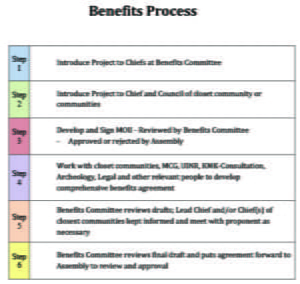The KMK Benefits Department works to ensure Mi’kmaq inclusion and participation in projects happening in Nova Scotia.
The Benefits process is separate, but parallel to the Consultation process. While it is the Crown that has the duty to Consult, proponents are benefiting from the lands and resources of Mi’kma’ki and are expected to develop a relationship with Nova Scotia Mi’kmaq and ensure that benefits are received.
Impacts to cultural resources, wildlife, fish, the environment, and possible archaeological resources are first priority and no financial discussions take place until such time as the Assembly is satisfied with those sections of any potential agreement.
All Benefits Agreements are developed on behalf of all 13 Mi’kmaw communities in Nova Scotia, however special consideration is given to those communities who are in the closest proximity to a project and each Benefits Agreement is developed with engagement and input from those closest communities.
We develop many different types of agreements and relationships based on the type of project and what is appropriate on behalf of Nova Scotia Mi’kmaq.
In some cases Mi’kmaq are the majority owner in a partnership, in other cases the Mi’kmaq enter into a Joint Venture where we may not be the majority owner but are building capacity for community members. If the Assembly is considering a partnership or Joint Venture, due diligence on any potential partner must be done, not only on their suitability as partners, but also to determine if they are the best partner in their field. Separate companies are created that each community chooses to participate in as part of any Joint Venture agreement.
For major developments, the Assembly looks to develop a comprehensive Benefits Agreement that provides specific details on expectations and commitments.
The Benefits Process
The Assembly has a Benefits Committee which is composed of several Chiefs as well as the KMK Benefits Officer. The role of the Benefits Committee is to meet with potential partners, review draft agreements and make recommendations to the full Assembly.
There are several steps that are followed when a Benefits Agreement is being developed:

- Impacts to cultural resources, wildlife, fish, the environment and potential archaeological resources are first priority and no financial discussions take place until such time as the Assembly is satisfied with those sections of any agreement
MOUs
A Memorandum of Understanding (MOU) is a non-binding agreement that is used to outline priorities and topics that are expected to be included in any final Benefits Agreement.
The MOU is usually the first agreement signed with any proponent or potential partner. It acts as a framework for future discussions to ensure that all parties are moving forward with the same basic understanding of expectations.
Signing an MOU does not mean that future discussions are always smooth, but they do provide parameters and expectations for topics and items that will be included in any future agreements.
The signing of an MOU does not imply or grant Assembly approval of any project. It merely provides a seat at the table that allows the Assembly to have more robust conversations with the proponent and work to address any concerns they might have about the project, while also working to increase the benefits to all Nova Scotia Mi’kmaq from development of lands and resources of Mi’kma’ki.
Benefits Agreements
For too long development of the lands and resources of Mi’kma’ki have been happening without any meaningful benefits for Nova Scotia Mi’kmaq. The Benefits Department has the responsibility to ensure that developments are done in a responsible manner that reflects Mi’kmaq values and priorities, while also ensuring that benefits of development are received by Mi’kmaq.
A Benefits Agreement is the final agreement that is signed between a proponent of a major development and the Assembly of Nova Scotia Mi’kmaw Chiefs on behalf of their communities. Any individual community may opt out of any agreement, but the goal is to have any agreement address community concerns so all communities are comfortable participating.
Each agreement is different depending on the nature, size and scope of the project, but there are key topics that will be included in every agreement:
- Protection of Aboriginal Rights and Title
- MEKS and discussion of ongoing traditional use access
- Fisheries
- Archaeology
- Training/Education/Bursaries
- Programming for business development
- Procurement opportunities, including tracking
- Employment targets, including tracking
- Mi’kmaq representation
- Ongoing communications
What Agreements Have Been Signed to Date?
MOUs
- Donkin Mine – July, 2012
- Port Hawkesbury Paper – October 24, 2012
- Pieridae Energy – August 23, 2013
- Maritime Link – November 13, 2013
- Shell Canada Limited – November 13, 2014
- DDV Gold – May 5, 2014
- Bear Head LNG – March 27, 2015
- BP Canada Energy Group ULC – November 29, 2017
- ExxonMobil Canada Properties – October 4, 2018
- Black Point Aggregates Ltd – July 21, 2019
- Anaconda Gold – June 28, 2019
- Maritime Launch – June 28, 2019
- NSPI – August 2019
Ongoing MOU Discussions
- Avalon Advanced Materials
- Nova Innovation
- Black Rock Tidal
- Atlantic Mining NS Inc (AG)
Finalized Benefits Agreements
- Kameron Coal/Donkin Mine – April 20, 2016
- Bear Head LNG – February 2, 2019
- Pieridae Energy – February 2, 2019
Existing Partnerships
- Beaubassin Wind
- Whynotts Wind
- Mi’kma’ki Domiculture
- Atlanticann Medical Inc.
- Clearwater Seafoods
